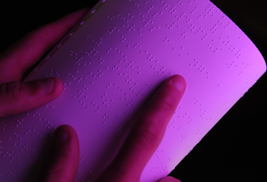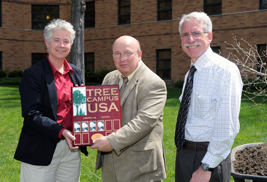Featured Article
Kent State University Honored With Tree Campus USA Designation for Fifth Consecutive Year
The Arbor Day Foundation recently honored Kent State University with a Tree Campus USA designation for the fifth consecutive year.
read moreKent State University's ADA Accessibility Highlights
Posted Feb. 18, 2013
Kent State University continues its tradition of excellence
in awareness of and responsiveness to accessibility
concerns to offer a campus environment that is inclusive
and welcoming of students, faculty, staff and community
members with disabilities.
Even before sweeping changes resulted from the passage of the 1990 Americans with Disabilities Act (ADA), Kent State University had been a trailblazer in disability awareness and responsiveness to student needs. In 1971, recognizing the unique challenges posed by students with disabilities and particularly those with mobility impairments, the university established the Office of Services for Handicapped Students.
That office was, essentially, the precursor to what is now Student Accessibility Services. Student Accessibility Services now serves approximately 1,100 students a year with various disabilities, including mobility impairments, learning disabilities, psychological disabilities, medical disabilities and students who are blind/low-vision, and those who are D/deaf and hard of hearing. Ensuring equal access to educational opportunities, Student Accessibility Services provides students services that are often imperative to those students reaching their academic goals. Student Accessibility Services also comport with the first of the university's strategic plan, that of ensuring student success.
Although accessibility challenges will always be present to some extent, Kent State continues its tradition of excellence in awareness of and responsiveness to accessibility concerns. Examples of this continuing tradition of excellence include, but are certainly not limited to, the following:
- In the fall of 2011, the university re-commissioned the formation of a campuswide committee tasked with examining issues related ADA accessibility concerns. Now called the ADA Advisory Committee, its membership draws from wide university representation including faculty, deans, staff from various departments and students. The committee is charged with examining not just compliance with ADA law, but continuing the university's excellence in this arena in identifying issues and recommending solutions that will enhance Kent State's inclusiveness of and advocacy for people with disabilities.
- Kent State President Lester A. Lefton has directed that funds be set aside to address university accessibility issues or concerns, above and beyond legal compliance. The ADA Advisory Committee will provide recommendations as to where those funds would best be used.
- The university is poised to hire a university accessibility liaison who will serve as a central conduit through which accessibility concerns and questions, including those from faculty, staff, community members and students, can be addressed and remedied. This accessibility liaison will help promote the welcoming and inclusive nature of Kent State particularly to those university and/or community members with disability/accessibility related needs.
- Both the ADA Advisory Committee and Student Accessibility Services staff are working to enhance dialogue with faculty to better address disability/accessibility issues within the classroom. Through faculty senate presentations, Student Accessibility Services’ faculty newsletters, collaborations with faculty on various initiatives, informal conversations with individual instructors and formal meetings with academic departments, we are attempting to bridge gaps and make accessibility for students as seamless as possible across the university and particularly within the curriculum.
- Staff members from Student Accessibility Services and the Office of Continuing and Distance Education are closely collaborating to ensure full accessibility within the Online Learning Strategic Initiative. More specifically, they are ensuring that online audio materials (e.g. narrated PowerPoint presentations, embedded video or YouTube clips, etc.) that will be used in these courses are captioned for students who are D/deaf or hard-of-hearing. Their work is aided significantly by the fact that accessibility is considered during the planning phase of course curricula, and accessibility features are built into the curriculum prior to the class going "live," so that retro-fitting and/or remediating the curriculum to make it accessible is minimal.
Arguably, accessibility challenges will always be present within any university setting, but Kent State is continuing its tradition of excellence in this arena and taking proactive measures to ensure that it leads the way in offering an environment that is inclusive and welcoming of students, faculty, staff and community members with disabilities.
For more information about Kent State’s Student Accessibility Services, visit www.kent.edu/sas.
